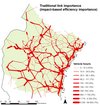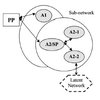 The Royal Institute of Technology in Stockholm, Sweden KTH is in the finishing stages of a research project aiming to develop the methodology for vulnerability analysis of road networks that can be used for decision-making concerning investment and maintenance measures. At the forefront is Erik Jenelius, a young researcher and PhD-student, who is breaking new grounds in the way we should think about road vulnerability and how to mitigate it.
The Royal Institute of Technology in Stockholm, Sweden KTH is in the finishing stages of a research project aiming to develop the methodology for vulnerability analysis of road networks that can be used for decision-making concerning investment and maintenance measures. At the forefront is Erik Jenelius, a young researcher and PhD-student, who is breaking new grounds in the way we should think about road vulnerability and how to mitigate it.
Vulnerability Analyses of Road Networks
There is an extensive list of publications and work reports on the project home page, well worth a read.
Indicators of the importance of a link and of the exposure of a region from a vulnerability perspective will be developed. A modelling tool will be developed by which these indicators can be calculated. An interface will be developed for the transference of data from other systems to this tool. A GIS-based tool will be developed for visualising the results. Specific vulnerability analyses will be carried out for different road regions in consultation with the Swedish Road Administration. These analyses will point out certain links as particularly important for the functioning of the network and certain municipalities as particularly exposed. The possibilities for the inclusion of vulnerability analyses in operation and maintenance planning and in investment planning will be studied.
Erik Jenelius
Erik Jenelius is the driving force behind the research. I happened to meet him at The NECTAR Cluster 1 Seminar, where he presented his research on transport network vulnerability, and where I presented my own paper on a similar topic, in which I referenced Jenelius, since he is one step ahead of my own research.
The increase in generalised travel costs weighted by the satisfied or unsatisfied demand when network links are closed is used as a measure of vulnerability for a case study in Northern Sweden, and applied to the terms of importance and exposure. Together these measure provide substantial information to planners, road administrations and individual municipalities as to where the most vulnerable (exposed and or/important) links in the network are.
Erik has published a lot more since then, and it can all be found on the project homepage.
Reference
JENELIUS, E., PETERSEN, T., & MATTSSON, L. (2006). Importance and exposure in road network vulnerability analysis Transportation Research Part A: Policy and Practice, 40 (7), 537-560
Links
- linkedin.com: Erik Jenelius












